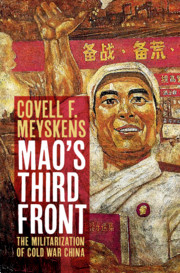Book contents
- Mao’s Third Front
- Mao’s Third Front
- Copyright page
- Contents
- Tables
- Figures
- Maps
- Abbreviations
- Acknowledgements
- Introduction
- 1 The Coming of the Third Front Campaign
- 2 Good People and Good Horses Go to the Third Front
- 3 Concentrating Forces to Wage Wars of Annihilation
- 4 Produce First and Consume Later
- 5 Industrial Development amid Cold War Insecurity
- Epilogue: The Demilitarization of Chinese Socialism
- Appendix: Third Front Demographics
- Bibliography
- Index
2 - Good People and Good Horses Go to the Third Front
Published online by Cambridge University Press: 24 April 2020
- Mao’s Third Front
- Mao’s Third Front
- Copyright page
- Contents
- Tables
- Figures
- Maps
- Abbreviations
- Acknowledgements
- Introduction
- 1 The Coming of the Third Front Campaign
- 2 Good People and Good Horses Go to the Third Front
- 3 Concentrating Forces to Wage Wars of Annihilation
- 4 Produce First and Consume Later
- 5 Industrial Development amid Cold War Insecurity
- Epilogue: The Demilitarization of Chinese Socialism
- Appendix: Third Front Demographics
- Bibliography
- Index
Summary
Chapter 2 examines how the CCP recruited millions of workers to construct the Third Front. Party officials sought to socially engineer a labor force that embraced Maoist norms and disregarded difficulties that moving to remote inland areas brought to their family or their own person. In practice, people responded to recruitment in various ways. Some thought of expanding China’s industrial defenses as a way of manifesting their devotion to Chinese socialism. Many others were more concerned about the material benefits and burdens that Third Front participation would bring to their region, factory, family, or self. Shanghai leaders urged central planners not to neglect the coast, whereas administrators in inland provinces requested more skilled workers and equipment. Urban residents fretted over what housing, schooling, and cultural activities would be available in China’s impoverished hinterlands. Rural youth, on the other hand, were eager to earn higher wages. But many of their parents were worried about losing household labor and the possibility that their children might be accidentally injured or die. Overall, my research illustrates that the consequences of enlisting in the Third Front were not always clear and that the value of being involved varied according to one’s geographical, social, and economic position.
Keywords
- Type
- Chapter
- Information
- Mao's Third FrontThe Militarization of Cold War China, pp. 79 - 121Publisher: Cambridge University PressPrint publication year: 2020

